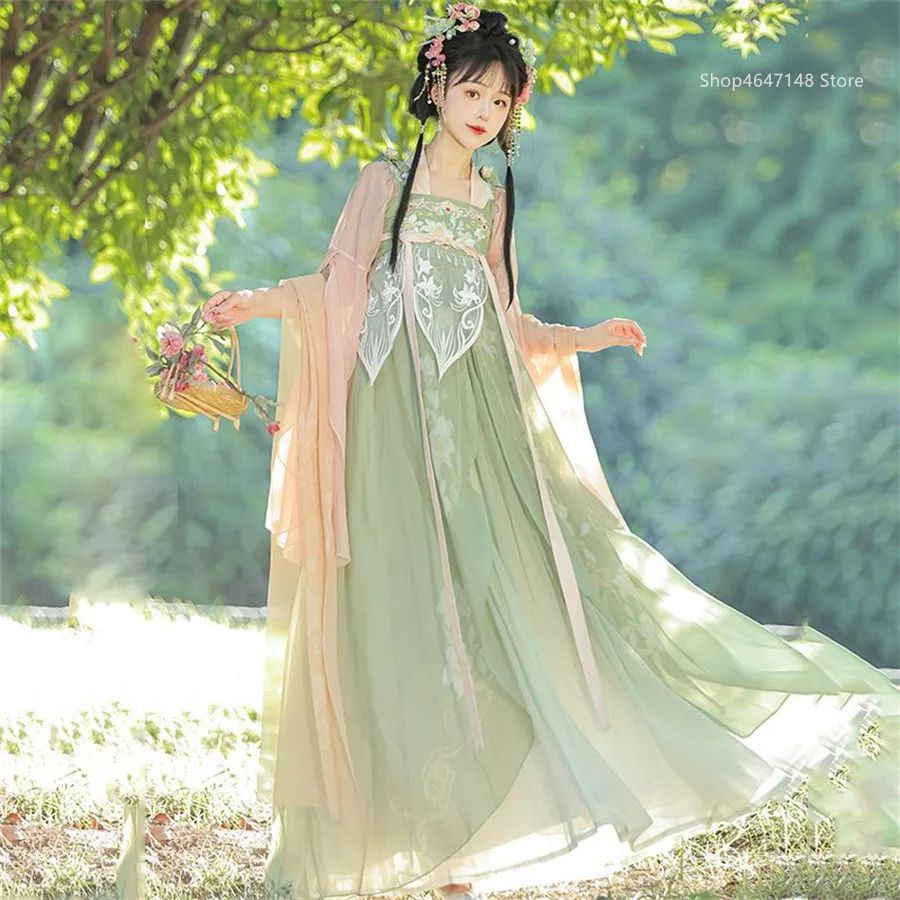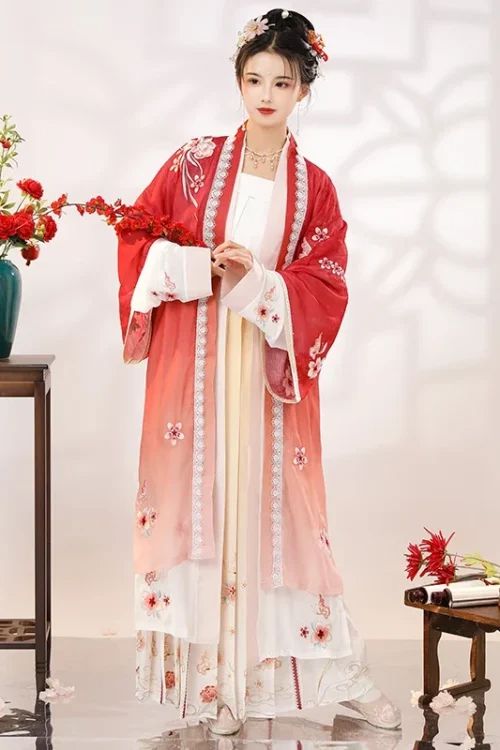The Historical Evolution of the Lotus Pattern in Hanfu
The lotus pattern, an enduring symbol of purity and elegance, has graced Hanfu, the traditional attire of the Han Chinese, for centuries. Its origins can be traced back to ancient Chinese mythology and religious beliefs.

Mythological Origins
In Chinese mythology, the lotus is associated with the goddess Nüwa, who is said to have created humans from the mud of the Yellow River. The lotus is believed to have sprung from Nüwa’s tears, symbolizing the birth of life and the connection between humans and nature.
Influence of Buddhism
Buddhism, which arrived in China during the Han dynasty, further solidified the lotus’s significance. In Buddhist iconography, the lotus represents purity, enlightenment, and transcendence. The Buddha is often depicted seated on a lotus throne, symbolizing his detachment from worldly desires and his attainment of spiritual perfection.
Emergence in Hanfu
The lotus pattern began to appear on Hanfu during the Han dynasty (206 BCE – 220 CE). Initially, it was used sparingly as a decorative motif on silk robes and accessories. However, its popularity grew steadily over time, and by the Tang dynasty (618 – 907 CE), the lotus had become a ubiquitous design element in Hanfu.
Artistic Expression in the Dynastie Tang
During the Tang dynasty, the lotus pattern reached its zenith of artistic expression. Skilled artisans employed a variety of techniques to create intricate and lifelike lotus designs. The lotus was often depicted in full bloom, with its delicate petals unfurling gracefully. The use of vibrant colors, such as red, pink, and blue, further enhanced the beauty and symbolism of the pattern.
Continued Popularity
The lotus pattern continued to be popular in Hanfu throughout the Song (960 – 1279 CE), Yuan (1271 – 1368 CE), and Ming (1368 – 1644 CE) dynasties. However, its significance gradually shifted from religious symbolism to a more secular aesthetic appreciation. The lotus became a symbol of beauty, elegance, and refinement, often adorning the clothing of both men and women.
Pertinence moderne
In modern times, the lotus pattern remains an important element of Hanfu design. It is often incorporated into contemporary Hanfu vêtements, ranging from formal robes to casual wear. The lotus pattern serves as a reminder of the rich cultural heritage of Hanfu and the enduring significance of this ancient symbol.
Symbolism and Cultural Significance of the Lotus Pattern in Hanfu
The lotus pattern, an enduring symbol of purity and elegance, has graced the flowing robes of Hanfu, the traditional tenue vestimentaire of the Han Chinese, for centuries. Its origins can be traced back to ancient Chinese mythology and religious beliefs.

Mythological Connections
In Chinese mythology, the lotus is associated with the goddess Nüwa, who is said to have created humans from the mud of the Yellow River. The lotus is believed to have sprung from the goddess’s tears, symbolizing the birth of life and the connection between humanity and nature.
Buddhist Influence
Buddhism, which arrived in China during the Han dynasty, further solidified the lotus’s significance. In Buddhist iconography, the lotus represents purity, enlightenment, and transcendence. The Buddha is often depicted seated on a lotus throne, symbolizing his detachment from worldly desires and his attainment of spiritual awakening.
Adoption in Hanfu
The lotus pattern found its way onto Hanfu during the Han dynasty (206 BCE – 220 CE). Initially, it was primarily used on the robes of the imperial court and nobility. However, as Buddhism spread throughout China, the lotus pattern became more widely adopted by the general population.
Decorative and Symbolic Elements
The lotus pattern was typically embroidered or woven into the fabric of Hanfu. Common motifs included single lotus flowers, lotus buds, and lotus vines. The colors used were often vibrant and symbolic, with red representing passion, green symbolizing growth, and blue denoting tranquility.
Aspirations and Beliefs
The lotus pattern on Hanfu served not only as a decorative element but also as a symbol of the wearer’s beliefs and aspirations. For the elite, it represented their connection to the divine and their pursuit of enlightenment. For the common people, it symbolized their hopes for a better life and their connection to the natural world.
Evolution of the Pattern
Over time, the lotus pattern evolved and diversified. During the Tang dynasty (618-907 CE), it became more elaborate and stylized, with the addition of other auspicious symbols such as dragons and phoenixes. In the Song dynasty (960-1279 CE), the lotus pattern became more naturalistic, focusing on capturing the delicate beauty of the flower.
Contemporary Significance
Today, the lotus pattern remains an integral part of Hanfu. It is used on both formal and informal garments, and its symbolism continues to resonate with Chinese people. The lotus pattern on Hanfu serves as a reminder of the rich cultural heritage of China and the enduring power of its ancient beliefs and traditions.
The Influence of Buddhism on the Lotus Pattern in Hanfu
The lotus pattern, a ubiquitous motif in Hanfu, the traditional clothing of the Han Chinese, holds a profound significance that transcends its aesthetic appeal. Its origins can be traced back to the introduction of Buddhism into China during the Han dynasty.

Buddhism’s Reception in China
Buddhism, with its emphasis on purity and enlightenment, found a receptive audience in China. The lotus flower, revered in Buddhist iconography as a symbol of spiritual awakening, became a potent symbol of the Buddhist faith. As Buddhism flourished, its influence permeated various aspects of Chinese culture, including the arts and fashion.
Decorative Integration
The lotus pattern, with its intricate petals and graceful curves, was adopted into Hanfu as a decorative element. It adorned robes, skirts, and accessories, imbuing them with a sense of serenity and spiritual significance. The lotus pattern became a symbol of purity, transcendence, and the pursuit of enlightenment.
Artistic Evolution
The lotus pattern in Hanfu evolved over time, reflecting the changing artistic styles and cultural influences. During the Tang dynasty, the lotus pattern became more elaborate, featuring intricate embroidery and embellishments. In the Song dynasty, it was often combined with other auspicious motifs, such as cranes and clouds, to create harmonious and visually stunning designs.
Shift in Popularity
The lotus pattern’s popularity extended beyond the realm of religious symbolism. It became a symbol of beauty, elegance, and refinement. The lotus flower’s association with purity and grace made it a fitting motif for garments worn by women, particularly during special occasions.
Contemporary Relevance
In contemporary times, the lotus pattern continues to be a cherished element in Hanfu. It is incorporated into modern designs, blending traditional aesthetics with contemporary sensibilities. The lotus pattern serves as a reminder of the enduring influence of Buddhism on Chinese culture and the enduring beauty and significance of this timeless motif.
